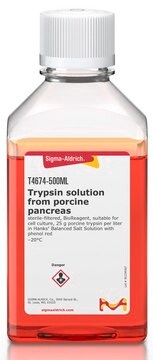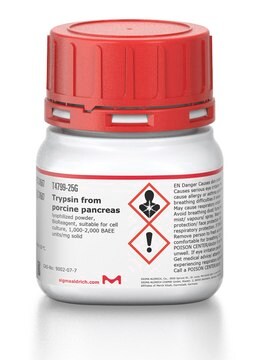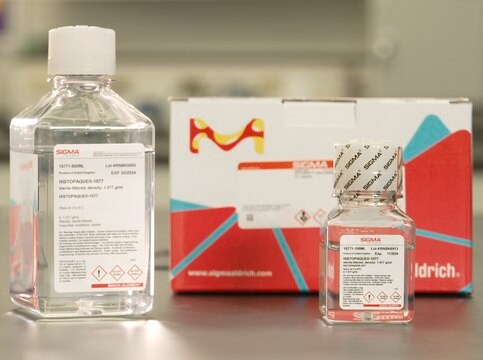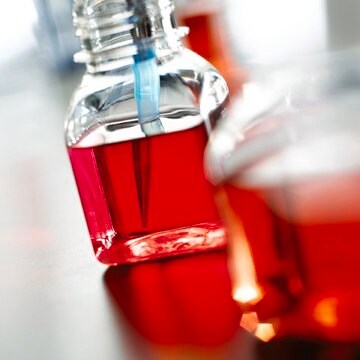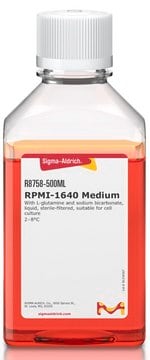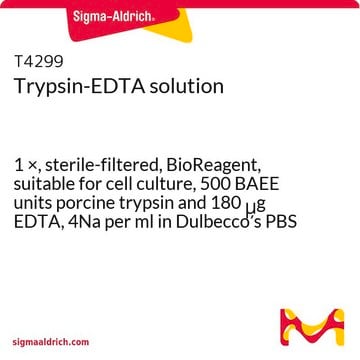T4549
Trypsin solution from porcine pancreas
sterile-filtered, BioReagent, suitable for cell culture, 25 g porcine trypsin per liter in 0.9% sodium chloride
Se connecterpour consulter vos tarifs contractuels et ceux de votre entreprise/organisme
About This Item
Numéro CAS:
Numéro MDL:
Code UNSPSC :
12352204
Nomenclature NACRES :
NA.75
Produits recommandés
Source biologique
Porcine
Niveau de qualité
Stérilité
sterile-filtered
Gamme de produits
BioReagent
Forme
solution
Poids mol.
23.4 kDa
Technique(s)
cell culture | mammalian: suitable
pH
7.6
Conditions d'expédition
dry ice
Température de stockage
−20°C
Vous recherchez des produits similaires ? Visite Guide de comparaison des produits
Application
For trypsin digestion of peptides, use a ratio of about 1:100 to 1:20 for trypsin:peptide. The typical use for this product is in removing adherent cells from a culture surface. The concentration of trypsin necessary to dislodge cells from their substrate is dependent primarily on the cell type and the age of the culture. Trypsins have also been used for the re-suspension of cells during cell culture, in proteomics research for digestion of proteins and in various in-gel digestions. Additional applications include assessing crystallization by membrane-based techniques and in a study to determine that protein folding rates and yields can be limited by the presence of kinetic traps.
Actions biochimiques/physiologiques
Trypsin cleaves peptides on the C-terminal side of lysine and arginine residues. The rate of hydrolysis of this reaction is slowed if an acidic residue is on either side of the cleavage site and hydrolysis is stopped if a proline residue is on the carboxyl side of the cleavage site. The optimal pH for trypsin activity is 7-9. Trypsin can also act to cleave ester and amide linkages of synthetic derivatives of amino acids. EDTA is added to trypsin solutions as a chelating agent that neutralizes calcium and magnesium ions that obscure the peptide bonds on which trypsin acts. Removing these ions increases the enzymatic activity.
Serine protease inhibitors, including DFP, TLCK, APMSF, AEBSEF, and aprotinin, amongst others, will inhibit Trypsin.
Serine protease inhibitors, including DFP, TLCK, APMSF, AEBSEF, and aprotinin, amongst others, will inhibit Trypsin.
Attention
This product should be stored frozen at -20°C.
Définition de l'unité
One BAEE unit will produce a A253 of 0.001 per minute at pH 7.6 at 25°C using BAEE as a substrate.
Notes préparatoires
This is 25 g/L porcine trypsin solution in 0.9% sodium chloride.
Produit(s) apparenté(s)
Mention d'avertissement
Danger
Mentions de danger
Conseils de prudence
Classification des risques
Eye Irrit. 2 - Resp. Sens. 1 - Skin Irrit. 2 - STOT SE 3
Organes cibles
Respiratory system
Code de la classe de stockage
10 - Combustible liquids
Classe de danger pour l'eau (WGK)
WGK 1
Point d'éclair (°F)
Not applicable
Point d'éclair (°C)
Not applicable
Faites votre choix parmi les versions les plus récentes :
Déjà en possession de ce produit ?
Retrouvez la documentation relative aux produits que vous avez récemment achetés dans la Bibliothèque de documents.
Les clients ont également consulté
Guoqian He et al.
Apoptosis : an international journal on programmed cell death, 21(4), 390-403 (2016-02-18)
Autophagic (type II) cell death has been suggested to play pathogenetic roles in cerebral ischemia. Growth arrest and DNA damage response 45b (Gadd45b) has been shown to protect against rat brain ischemia injury through inhibiting apoptosis. However, the relationship between
Sei-Jung Lee et al.
Food and chemical toxicology : an international journal published for the British Industrial Biological Research Association, 87, 12-22 (2015-12-04)
This study was carried out to investigate the anti-inflammatory potentials of a 38 kDa glycoprotein isolated from Styrax japonica Siebold et al Zuccarini (SJSZ glycoprotein). We found that SJSZ glycoprotein has concentration-dependent scavenging activity against DPPH and hydroxyl radicals in the cell-free
Volker Kroehne et al.
Frontiers in cellular neuroscience, 11, 284-284 (2017-09-30)
Endogenous oligodendrocyte progenitor cells (OPCs) are a promising target to improve functional recovery after spinal cord injury (SCI) by remyelinating denuded, and therefore vulnerable, axons. Demyelination is the result of a primary insult and secondary injury, leading to conduction blocks
Yochai Wolf et al.
Cell, 179(1), 219-235 (2019-09-17)
Although clonal neo-antigen burden is associated with improved response to immune therapy, the functional basis for this remains unclear. Here we study this question in a novel controlled mouse melanoma model that enables us to explore the effects of intra-tumor
Guo-Qian He et al.
Molecular medicine reports, 22(6), 5083-5094 (2020-11-12)
Autophagy and the ubiquitin proteasome system (UPS) are two major protein degradation pathways involved in brain ischemia. Autophagy can compensate for UPS impairment‑induced cellular dysfunction. HECT, UBA and WWE domain containing E3 ubiquitin protein ligase 1 (Huwe1), an E3 ubiquitin ligase, serves critical roles
Notre équipe de scientifiques dispose d'une expérience dans tous les secteurs de la recherche, notamment en sciences de la vie, science des matériaux, synthèse chimique, chromatographie, analyse et dans de nombreux autres domaines..
Contacter notre Service technique